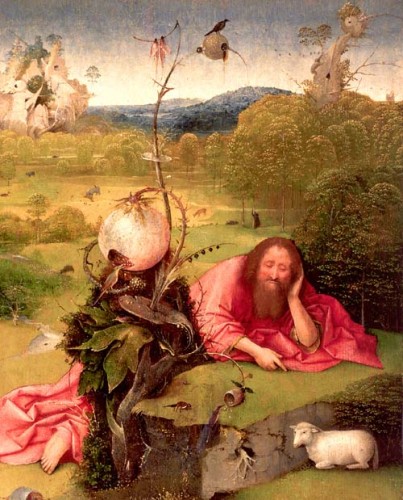The exhibition was stunning. Beautifully set out and the areas under discussion made for a journey through the world of Bosch, his workshop and his followers.
The highlights for me were:
- Death and The Miser
- The Wayfarer
- Saint John the Baptist
- The Last Judgement
- Visions of the Hearafter
Death and The Miser
This was possibly my favourite. There is so much detail in this piece that I feared that I would get no further than this one. The angel gestures towards the crucified Christ to show the miser that the only way to salvation is through Christ, but from under the curtain, a demon offers the man a bag of money as Death, with an arrow pointing directly at the miser, revealing that time is running out to choose. This image seems to confirm Bosch’s belief that people are utimately responsible for the choices they make in life.
The composition is narrow but the use of lines is integral to this. Your eye zigzags across the canvas starting with the disguarded lance in the foreground, with the helmet, shield and gauntlet abandoned – perhaps representing the end of a life. We then move along the wall that appears to be guarded by an imp – similar to one seen in Garden of Delights. This figure has a casual air about him which, given that he is a harbinger of death, seems a little incongruous. The central figure is possibly our dying man in earlier life, storing his wealth but surrounded by creatures that create a humour to this. If we then follow the angel’s pointed hand up to the crucifix in the window, back down along the glow and then again with the pointed arrow, we are confronted with the moment of choice. It is a split second judgement on behalf of the man. Which will he choose? We are left to wonder.
The palette was also of interest as there is an abundance of pink in this painting symbolising divinity – something we see a lot in Bosch’s depictions of Heaven – so can we say that the miser made his choice and rejecting his lifetime work?
The Wayfarer
I was interested to discover that Bosch was the first artist to paint ordinary people rather than religious subjects and this painting certainly ‘holds up the mirror’. The Traveller walks away from a house of loose morals and looks back with an enigmatic expression: is he appalled at what he has seen, or does he long to return and be tempted by what is on offer?
As with all of Bosch’s paintings, nothing is there by chance and it is our own interpretations we can indulge with his work.
The tiny details were fascinating – the use of white paint on the backs pigs and on the spray of urine can only be seen up close and I really liked the evil glint in the ow’s eye as he is about to pounce on his prey. Not all the bad behaviour was restricted to the house!
Saint John the Baptist
I have included this for one reason only – how bored does John the Baptist look here? I’m not so sure that the catalogue was right with its description of him lying ‘pensively’. As John was the ‘one who came before’, this image made me wonder whether he was happy with this situation: “here was a man sent from God, whose name was John. 7 This man came for a witness, to bear witness of the Light, that all through him might believe. 8 He was not that Light, but was sent to bear witness of that Light.” John 1: 6-8







